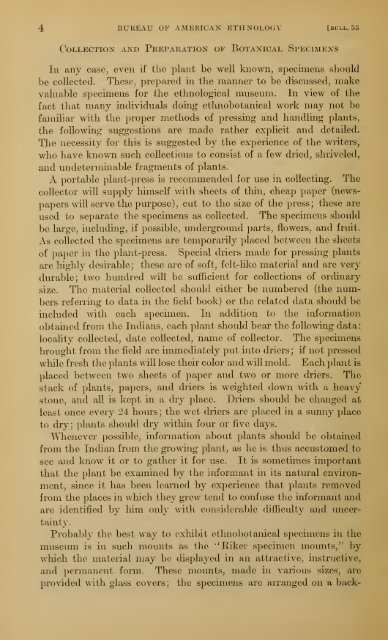Untitled - Smithsonian Institution
Untitled - Smithsonian Institution
Untitled - Smithsonian Institution
You also want an ePaper? Increase the reach of your titles
YUMPU automatically turns print PDFs into web optimized ePapers that Google loves.
4 BUREAU OF AMERICAN ETHNOLOGY [bull. 55<br />
Collection and Preparation of Botanical Specimens<br />
111 any case, even if the plant be well known, specimens should<br />
be collected. These, prepared m the manner to be discussed, make<br />
valuable specimens for the ethnological museum. In view of the<br />
fact that many individuals doing ethnobotanical work may not be<br />
familiar with the proper methods of pressing and handling plants,<br />
the following suggestions are made rather explicit and detailed.<br />
The necessity for this is suggested by the experience of the writers,<br />
who have known such collections to consist of a few dried, shriveled,<br />
and undeterminable fragments of plants.<br />
A portable plant-press is recommended for use in collecting. The<br />
collector will supply liimself with sheets of thin, cheap paper (news-<br />
papers will serve the purpose), cut to the size of the press; these are<br />
used to separate the specimens as collected. The specimens should<br />
be large, including, if possible, underground parts, flowers, and fruit.<br />
As collected the specimens are temporarily placed between the sheets<br />
of paper in the plant-press. Special driers made for pressing plants<br />
are highly desirable ; these are of soft, felt-like material and are very<br />
durable; two hundred will be sufficient for collections of ordinary<br />
size. The material collected should either be numbered (the numbers<br />
referring to data in the field book) or the related data should be<br />
included with each specimen. In addition to the information<br />
obtained from the Indians, each plant should bear the following data:<br />
locality collected, date collected, name of collector. The specimens<br />
brought from the field are immediately put into driers; if not pressed<br />
while fresh the plants will lose their color and will mold. Each plant is<br />
placed between two sheets of paper and two or more driers. The<br />
stack of plants, papers, and driers is weighted down with a heavy<br />
stone, and all is kept in a dry place. Driers should be changed at<br />
least once every 24 hours ; the wet driers are placed in a sunny place<br />
to dry; plants should dry within four or five days.<br />
Whenever possible, information about plants should be obtained<br />
from the Indian from the growing plant, as he is thus accustomed to<br />
see and know it or to gather it for use. It is sometimes important<br />
that the plant be examined by the informant in its natural environment,<br />
since it has been learned by experience that plants removed<br />
from the places in wliich they grew tend to confuse the informant and<br />
are identified by liim only with considerable difficulty and uncer-<br />
tainty.<br />
Probably the best way to exhibit ethnobotanical specimens in the<br />
museum is in such mounts as the "Piker specimen mounts,'' by<br />
which the material may be displayed in an attractive, instructive,<br />
and permanent form. These mounts, made in various sizes, are<br />
provided with glass covers; the specimens are arranged on a back-

















